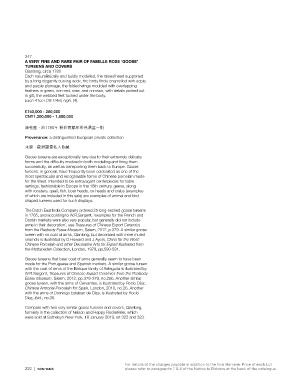Page 224 - Bonhams May 16, 2019 London Asian Art
P. 224
247
A VERY FINE AND RARE PAIR OF FAMILLE ROSE ‘GOOSE’
TUREENS AND COVERS
Qianlong, circa 1780
Each naturalistically and boldly modelled, the raised head supported
by a long elegantly curving neck, the body finely enamelled with sepia
and purple plumage, the folded wings moulded with overlapping
feathers in green, iron-red, rose, and crimson, with details picked out
in gilt, the webbed feet tucked under the body.
Each 41cm (16 1/4in) high. (4).
£150,000 - 200,000
CNY1,300,000 - 1,800,000
清乾隆,約1780年 粉彩寶鵝形帶蓋湯盆一對
Provenance: a distinguished European private collection
來源:歐洲顯貴私人收藏
Goose tureens are exceptionally rare due to their extremely delicate
forms and the difficulty involved in both modelling and firing them
successfully, as well as transporting them back to Europe. Goose
tureens, in general, have frequently been celebrated as one of the
most spectacular and recognisable forms of Chinese porcelain made
for the West. Intended to be extravagant centerpieces for table
settings, fashionable in Europe in the 18th century, geese, along
with roosters, quail, fish, boar heads, ox heads and crabs (examples
of which are included in this sale) are examples of animal and bird-
shaped tureens used for such displays.
The Dutch East India Company ordered 25 long-necked goose tureens
in 1765, and according to W.R.Sargent, ‘examples for the French and
Danish markets were also very popular, but generally did not include
arms in their decoration’, see Treasures of Chinese Export Ceramics
from the Peabody Essex Museum, Salem, 2012, p.379. A similar goose
tureen with no coat of arms, Qianlong, but decorated with more muted
enamels is illustrated by D.Howard and J.Ayers, China for the West:
Chinese Porcelain and other Decorative Arts for Export illustrated from
the Mottahedeh Collection, London, 1978, pp.590-591.
Goose tureens that bear coat of arms generally seem to have been
made for the Portuguese and Spanish markets. A similar goose tureen
with the coat of arms of the Basque family of Asteguita is illustrated by
W.R.Sargent, Treasures of Chinese Export Ceramics from the Peabody
Essex Museum, Salem, 2012, pp.378-379, no.206. Another similar
goose tureen, with the arms of Cervantes, is illustrated by Rocío Díaz,
Chinese Armorial Porcelain for Spain, London, 2010, no.26. Another
with the arms of Domingo Esteban de Olza, is illustrated by Rocío
Díaz, ibid., no.36.
Compare with two very similar goose tureens and covers, Qianlong,
formerly in the collection of Nelson and Happy Rockefeller, which
were sold at Sotheby’s New York, 18 January 2019, lot 322 and 323.
For details of the charges payable in addition to the final Hammer Price of each Lot
222 | BONHAMS please refer to paragraphs 7 & 8 of the Notice to Bidders at the back of the catalogue.

